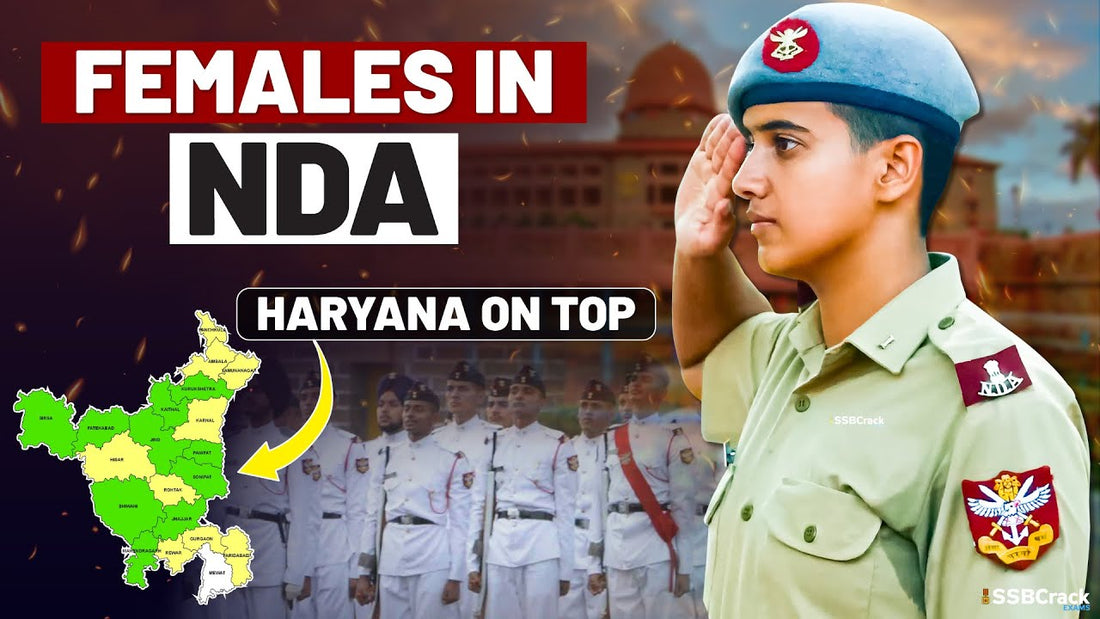Haryana Has Highest Number of Girl Cadets in National Defence Academy

The National Defence Academy (NDA) stands as a beacon of hope and opportunity, particularly as it embarks on its journey towards gender inclusivity with the enrollment of female cadets. Among the states leading this charge is Haryana, renowned for its deep-rooted traditions and cultural significance, now emerging as a powerhouse for female representation in India's military training. It is a momentous shift, not just for the state but for women across the nation, symbolizing progress and the breaking down of societal barriers that have long constrained their participation in defense services. The increasing number of girl cadets from Haryana, which currently stands at 34 to 35, serves as a testament to this evolution.
Historical Context
The journey towards female enrollment in the NDA was not a straightforward trajectory. For decades, the NDA, established in 1954, was an exclusively male domain, creating entry barriers for aspiring female cadets. However, change began to take root with a landmark Supreme Court ruling in August 2021 which allowed women to sit for the NDA entrance exam for the first time in history. This ruling underscored an essential recognition of women’s rights to equal opportunities in all facets of life, including national service.
Following the ruling, the first batch of 19 girl cadets was inducted into the NDA in June 2022 as part of the NDA-148 course, marking a significant historical breakthrough. The subsequent increase in enrollment numbers reflects both a changing mindset and a concerted effort to foster gender equality within the armed forces.
The Significance of Haryana's Leadership
Haryana's prominent figure in contributing the highest number of girl cadets at the NDA cannot be understated. This achievement highlights several underlying aspects, including:
- Cultural Shift: Haryana has historically had a reputation for gender disparity, yet the emergence of female cadets from the state signals a pivotal cultural shift. The success stories of these cadets challenge old stereotypes and inspire a new generation of girls to pursue their aspirations aggressively.
- Government Initiatives: The increase in female cadet participation can be attributed to various initiatives by the state government, aimed at empowering females through education and vocational training. Such measures include scholarships, mentorship programs, and workshops that promote military careers.
- Increased Awareness: The realization within families about the importance of women in armed services has also contributed significantly. With high-profile role models, young girls are encouraged to dream beyond traditional career paths, influencing many to join the NDA.
State-Wise Distribution of Girl Cadets in the NDA
Haryana's leadership in cadet enrollment is not only significant in terms of numbers but also in how it compares with other states. The current state-wise distribution of girl cadets in the NDA is as follows:
- Haryana: 34-35 cadets
- Uttar Pradesh: 27-28 cadets
- Rajasthan: 13 cadets
- Maharashtra: 11 cadets
- Madhya Pradesh: 6 cadets
- Punjab: 4 cadets
- Other states: Including Assam, Bihar, Chhattisgarh, Delhi, Gujarat, Himachal Pradesh, Jammu and Kashmir, Karnataka, and Kerala, reflect a diverse representation aiming for growth.
With a total of 121 to 126 girl cadets currently undergoing training, it’s clear that Haryana's contribution makes it a leader in nurturing female talent for defence roles.
Rigorous Training Program at the NDA
Girl cadets at the NDA experience a rigorous training environment equivalent to that of their male counterparts. This equality in training is crucial for fostering a sense of camaraderie and respect between future leaders of the armed forces, irrespective of gender. The comprehensive three-year training program encompasses military and academic disciplines designed to create disciplined, physically fit, and strategically thinking officers.
Equal Facilities and Opportunities
The NDA has taken significant steps to ensure that female cadets have access to facilities and opportunities on par with male cadets.
- Accommodation: Proper living accommodations have been established specifically for female cadets, ensuring not just safety but also a conducive environment for training.
- Physical Training: Female cadets undergo the same physical training regimens aimed at building stamina and physical endurance required in the armed forces.
- Access to Academics: Girl cadets can avail themselves of all academic resources, including libraries, labs, and mentorship from experienced officers, fostering a well-rounded educational background.
Case Studies: Breaking Barriers
Several individuals from Haryana stand out as exemplary figures in this context, whose journey into the NDA serves as inspiration for many.
- One of the first female cadets from Haryana, Neha exemplified resilience and determination. Coming from a modest family background, She secured her spot in the NDA through relentless preparation and support from her family, emphasizing the importance of familial encouragement in breaking cultural barriers.
- Another notable case is that of a girl, who actively participated in various competitive sports, which honed her leadership and teamwork skills. She encourages peers to consider military careers as prestigious and fulfilling.
Statistical Data and Research Insights
The incorporation of women into the NDA aligns with global trends toward gender equality in military services. Countries around the globe, including the United States and the UK, have progressively opened their military academies to women, understanding that gender-diverse teams enhance operational effectiveness and decision-making.
In terms of statistics:
- As of now, there are close to 121-126 girl cadets in the NDA from various states.
- Haryana contributes 28.5% of the total girl cadets, making it a leader nationwide.
- Female representation in the Indian Defence forces has seen a steady increase, which is expected to rise commensurate with the increasing enrollment of girl cadets in military academies.
Comparative Analysis with Other States
Haryana's leading position in the number of female cadets can be contrasted with other states that have also made strides toward greater female military representation:
- Uttar Pradesh, while coming second, shows a similar trend and has made significant efforts toward improving educational frameworks for girls interested in defense careers.
- Maharashtra and Rajasthan are also catching up with substantial participation, focusing on enhancing educational facilities and providing a more robust support system for aspiring female military officers.
However, the disparity in numbers across different states highlights the need for increased awareness and targeted initiatives to promote female enrollment nationwide.
Challenges and Solutions
Despite the progress made, significant challenges remain.
- Cultural Barriers: In many parts of India, traditional beliefs about gender roles may deter women from pursuing a career in the military.
Solution: Educational campaigns targeting families and communities could help shift perceptions and encourage female participation.
- Mental Health Concerns: The pressure of rigorous training may impact mental health, particularly for young women who may face additional societal pressures.
Solution: Instituting dedicated mental health support for cadets could aid in ensuring their well-being during rigorous training.
- Logistical Issues: Ensuring the accommodation and facilities are up to standard remains a challenge to ensure comfort for female cadets.
Solution: Investments in infrastructure and training environments are paramount to equalize facilities for female cadets.
Future Trends and Predictions
Looking ahead, additional trends are likely to shape the future of the NDA and female participation:
- Expansion of Recruitment Drives: As awareness increases, we may see more extensive recruitment efforts directed toward women, highlighting success stories and potential career paths in the military.
- Enhanced Scholarships and Financial Aid: Financial support aimed specifically at female cadets can bolster participation, making military careers more accessible.
- Inclusion Initiatives: Increasing the role of women in leadership positions within military structures may support a more inclusive atmosphere at the NDA and beyond.
Conclusion
Haryana’s achievement of having the highest number of girl cadets in the National Defence Academy is not merely a statistic; it is a movement towards gender equality, empowerment, and societal change. As these young women embark on their training journeys, they carry with them the hopes and aspirations of countless others, redefining the narrative around women in the defence sector.
The commitment from state governments, families, and educational institutions will play a crucial role in fostering female representation in the military. It is imperative to support and encourage future generations of women to break barriers, step boldly into traditionally male-dominated arenas, and contribute to the nation’s security and honor at large. Such initiatives not only uplift individual lives but are critical to shaping a more inclusive society.
It is time for stakeholders and society to rally behind these young cadets, providing them with the encouragement and resources they need to thrive, not just in the NDA but in all facets of their lives. For those aspiring to follow in their footsteps, engaging with resources from SSBCrack and SSBCrackExams will be invaluable in preparing for the challenges ahead. Together, a path is being forged toward a future where no aspirations are limited by gender.



















